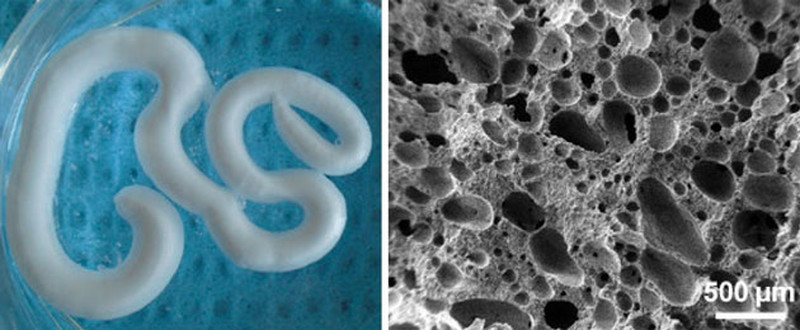
Researchers in France have developed a self-setting foam that can repair defects in bones and assist growth. Eventually, this advanced biomaterial could be used to quickly regenerate bone growth and treat degenerative diseases such as osteoporosis.
Injectable calcium phosphate cements (CPCs) have been around for nearly a hundred years, and they’re frequently used in orthopedics and traumathology as bone substitutes during surgery. These biomaterials allow surgeons to fix and harden defective bones “in situ” with relative ease and flexibility. What’s more, they’re biocompatible, self-setting, and non-toxic.
But as James Urquhart reports at Chemistry World, scientists haven’t been able to introduce macroporosity into these materials, which means these injectable cements don’t have pores, or cavities, larger than 50 nanometers. This makes it difficult to treat bone degeneration, or to strengthen cancellous bone—a porous, flexible and spongy tissue that gets progressively weaker once osteoporosis sets in.
Now, Pierre Weiss and his colleagues at the University of Nantes have achieved an important breakthrough in this area. By applying a sophisticated hydrogen as a foaming agent to create air bubbles in the mixture, the researchers have created an effective macroporous, self-setting CPC. The results of their work appears in the latest edition of Acta Biomaterialia.
The key to the breakthrough was in applying a silanized hydrogel as a foaming agent. James Urquhart explains:
Sponsored
Previously, the team had attempted to improve the mechanical properties [0f] CPC by adding a Si-HPMC hydrogel. But during the process of preparing the Si-HPMC hydrogel with an acidic buffer using syringes – which lowers the pH of the solution causing it to self-cross link and gel – air bubbles appeared in the mixture and they were hard to remove. But Weiss’ postdocs Jingtao Zhang and Weizhen Liu wondered if this drawback might be useful for giving macroporosity to CPC and so they set out to develop a CPC foam.
The team made the foam by putting Si-HPMC and CPC solutions in separate syringes, and then pumping air into the CPC syringe. Both syringes were then joined by a connector and plunged to rapidly mix the solutions and air, which formed a homogenous foam.
‘We knew that both biomaterials are biocompatible separately but we didn’t know how the body would react with a combination of both,’ explains Weiss. To find an answer, and also to test the biofunctionality of the foam, they conducted preliminary in vivo tests by making tiny defects in the thigh bones of two live rabbits and injected the foam into the cavities.
Their follow-up tests showed that new bone did indeed form at the implant sites, and with no toxic effects. The researchers would like to use the foam to treat certain bone defects and diseases, so their next step will be to determine the proof of concept in animal models.
Read more at Chemistry World. And check out the study at Acta Biomaterialia: “A simple and effective approach to prepare injectable macroporous calcium phosphate cement for bone repair: Syringe-foaming using a viscous hydrophilic polymeric solution”.
Email the author at george@gizmodo.com and follow him at @dvorsky. Top image by Elsevier
